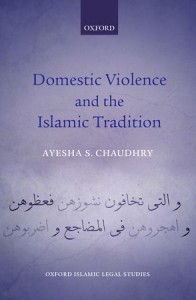Content note: This post includes discussions of domestic violence and of scholarly attempts to justify it.
For a number of Muslim women I know (myself included), one of the most complicated Qur’anic passages to contend with is verse 4:34, a verse that, at least in many of the most straightforward translations, appears to establish men as superior to women and to authorise (or even encourage) men to hit their wives if they “disobey.” Muslim feminist scholars have tried to address it in various ways – whether by suggesting alternative understandings of the verb commonly translated as “hit them” or by focusing on the ethical challenges posed by the verse – but it remains, for many, uncomfortable and difficult to reconcile with the notions of compassion and spiritual equality of genders that we also see in Islam.

Chaudhry starts off the book by chronicling her own personal discomfort with the verse and with people’s responses: the confusion she felt when she initially discovered the verse as a middle-schooler; her early impressions that the attention given to the verse was unwarranted when Islam gave women so many rights and she couldn’t imagine Muslim men abusing her wives; and later, her realisation that the verse was indeed being invoked in systematic ways to justify domestic violence and to blame women for the physical violence they were experiencing in their marriages. Chaudhry writes that she began to question religious scholars about the verse, and found them caught in a bind where they felt compelled to affirm the permission given in the verse for men to hit their wives, even if some of them tried to downplay it. She was consistently told that she would not feel so much angst about it if she had a better understanding of the Islamic tradition, and this book reflects her mission to investigate that tradition, although the results—at least, the historical ones—are perhaps more grim than she was expecting.
Beginning with such a personal introduction in a book about Qur’anic exegesis and histories of jurisprudence struck me as potentially risky; I wonder if some might see the resulting work as less “objective” as a result. That said, I deeply appreciated this move, which highlights that the interpretation of verse 4:34 should never be simply an intellectual question to be discussed from a removed, dispassionate perspective. For Muslim women who are, or may be one day, married to men, the discussions around this verse can have very direct implications on their lives and bodies. I know women whose abusive (now-former) husbands have used so-called Islamic principles to justify their violence. This is a profoundly personal issue for many people, and it matters that this book affirms that the question of domestic violence is not only an academic or legal issue. The personal tone of the introduction also reflects and illustrates Chaudhry’s contention that we can only approach the Qur’an through our own histories and worldviews, a point that I’ll return to later.
Chaudhry divides the book into two parts, looking at how verse 4:34 has been understood first in pre-colonial work (in Arabic) and then by post-colonial Islamic scholars (here, she looks at work in Arabic, English, and Urdu). She explains this division by noting the ways that pre-colonial Islamic scholarship is often pointed to as untainted by outside influence and alluded to by contemporary scholars as a source of authority to bolster their own positions.
The first part of the book looks at the pre-colonial period and contains three chapters, focusing, respectively, on historical points linked to the context of revelation, debates around the legal implications of verse 4:34, and the ethical questions posed by the verse. Chaudhry argues that classical scholars, while coming from different countries and time periods, shared remarkably similar “idealized cosmologies”—or “visions of the universe as it would exist if all humans submitted entirely to God’s laws” (p. 196)—when it came to gender. Such “idealized cosmologies” saw as natural—and desirable—a social hierarchy that placed men above women and thus morally and materially responsible for them, with women in turn responsible for obeying their husbands and fathers as part of what it meant to submit to God. The disciplinary role of husbands with regards to their wives was thus taken for granted, and the questions for pre-colonial scholars when it came to verse 4:34 were never about whether or not it was okay for husbands to hit their wives, but rather about exactly how hard they could hit and under what conditions. This isn’t to say that there weren’t still conflicting opinions. Although it seems that some classical scholars were intent on preserving the husband’s right to inflict any kind of physical “discipline” on his wife that he saw fit, short of killing her, others expressed more reservations, citing a hadith where the Prophet’s preference seems to conflict with—or at least to caution against—the apparent Qur’anic permission to hit (see this article for another discussion of that hadith). Nonetheless, none of the pre-colonial scholars that Chaudhry looked at argued that it was forbidden for husbands to hit their wives.
In the fourth chapter, Chaudhry moves to the post-colonial period, looking at how contemporary scholars have engaged with this verse in a context that requires them to find a balance between the patriarchal idealized cosmologies of the pre-colonial (and thus authoritative) scholarship and the more egalitarian idealized cosmologies of the contemporary period. In contrast to the precolonial scholars, post-colonial religious scholars are often working in contexts with competing worldviews when it comes to gender, and thus their interpretations of verses like 4:34 require more complicated interpretive work to account for and reconcile these multiple and sometimes conflicting perspectives. Chaudhry identifies four main currents of thought: traditionalists, who essentially uphold the pre-colonial views on the subject, while making more efforts than pre-colonial scholars did to justify their position on gender relations; neo-traditionalists, who try to represent the history of traditional scholarship as being more egalitarian, while ultimately allowing for the permission for husbands to hit wives, if in only limited circumstances; progressives, who oppose the idea that the Qur’an could permit husbands to hit wives, while trying to ground this opposition in traditional ideas and scholarship; and reformists, who make no attempts to base their positions on classical scholarship, emphasising principles of egalitarianism as their main concern when interpreting the verse.
The fifth and final chapter of the book focuses on the notion of “idealized cosmology” and looks at examples of how the interpreter’s own idealized cosmology (referring, again to the way that they understand what an ideal social order would look like) influences how the text is read and understood. In the conclusion, Chaudhry claims that “interpretations tell us more about the interpreters than about the text itself” (p. 224)—that multiple meanings are inevitable, and that the text only exists through how its readers understand it. She thus concludes the book by saying:
“Once authority is transferred away from a mythically pristine tradition to the living community that interacts with, embodies, and bears the scars of violent meanings attributed to this text, contemporary Muslims will be able to authoritatively posit nonviolent meanings of Q. 4:34. Thus, contemporary Muslims may fully belong to a religious tradition that they love, in the face of enduring challenges posed by texts whose pre-colonial plain-sense meanings they cannot abide.” (p. 224)
The study is a thorough and detailed exploration of both classical and contemporary positions on verse 4:34, and although this is not my area of academic specialty, the research struck me as overall very comprehensive. The writing is easy to follow even for a non-expert, and the footnotes are extensive for those wanting more background and evidence. I would have been interested to see more discussions of women’s perspectives from the pre-colonial period, if scholarship by women on this verse exists from that time (that said, there were women cited on all four positions described in the post-colonial section, so this is not to say that women’s answers would necessarily have been any different from men’s). I also would have liked to see more non-Western scholars quoted in the post-colonial section—not because non-Western perspectives are necessarily more legitimate or authoritative, but because the current structure of the book could be read as if it is only within Western contexts that perspectives have shifted, which seems unlikely.
I also appreciated that Chaudhry does not try to simplify things or to avoid difficult questions. She acknowledges that certain more egalitarian interpretations or representations of the tradition that might seem preferable are not necessarily logically or historically sound, and talks critically about the “intricate hermeneutical acrobatics” (p. 140) that some scholars engage in as they attempt to reconcile opposing positions together. Some will likely criticise this book for representing Islam, and particularly the Islamic scholarly tradition, in a negative light, and it’s true that it does this to some degree. On the other hand, the emphasis on idealized cosmologies makes it clear that Chaudhry’s point is not to condemn individual scholars but rather to demonstrate the role that our contexts influence the ways that we interpret religious texts, a point that is far from unique to Muslims. Moreover, if this is the scholarship we have to contend with, then we might as well be aware of it. If someone wants to disprove her by writing a book about all of the classical scholars who did prohibit all forms of physical violence within a marriage, scholars that Chaudhry managed to miss despite her best efforts to find them, I would love to see it. But in the absence of such a work, my own feeling is that those of us who try to write or speak or work against gendered violence in Muslim communities are better off being aware of the work that we have cut out for us. As Chaudhry herself wrote in a recent article,
“An indispensable step in this process of reinterpretation is an honest and unflinching examination of the religious tradition. Believers need not apologize or be ashamed of their history, but they must certainly not defend and perpetuate aspects of their religious tradition that are oppressive and tyrannical.”
I will say that the book was harder to read than I had expected, which is a comment on the emotional heaviness of the content and not on the writing style. It was difficult to spend so much time reading about all of the different situations in which people have deemed it appropriate for men to hit women, and exactly how much injury husbands are allowed to inflict. (A powerful response at the blog Sober Second Look, worth reading in its entirety, describes the effect of the book as “bone-freezingly horrifying.”) I had picked up the book feeling optimistic that it might provide a clear way through the dilemma of verse 4:34, that it might point to a history of non-violent interpretations, and that was certainly not what I found; if you’re hoping for something similar, consider yourself warned. Although I’m glad that Chaudhry didn’t try to sugar-coat this rather bleak history, I had hoped she might say more about the results of her own personal journey to think through this verse, in response to the struggles that she describes in her introductory chapter; while she points in the conclusion to some ways forward in how we interpret verse 4:34, I would have been interested in seeing her return to a more direct discussion of her own experience and perspective on the issue, and of where all this research has brought her on a more personal level.
Given how difficult this book was to read, I am all the more grateful to Chaudhry for having done the necessary research to write it. Despite being a much less rosy picture than I was hoping for, it is nonetheless an honest and rigorous look at the way this verse has been discussed in Muslim communities, and can serve as a powerful tool for those wanting to challenge the ways that violence is discussed and enacted within our communities today.












